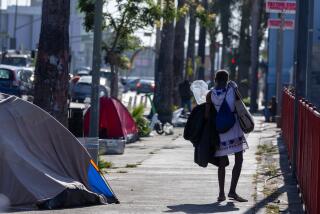Commentary : After Measure M’s Defeat, Orange County Needs to Weigh Its Options
Last Tuesday, five California counties--San Bernardino, San Francisco, Santa Barbara, Imperial and Monterey--all voted to approve a half-cent sales tax for transportation purposes. Now 18 California counties have transportation sales taxes in place.
But two counties, urban Orange County and tiny Nevada County, rejected sales tax increases for transportation on Tuesday.
With Tuesday’s vote count, more than 75% of the people in California now live in counties with a special source of transportation revenue. And only one urban county in California--Orange County--is left to scramble for other sources of transportation cash.
When looking at this gloomy situation, the initial reaction is to say that for Orange County, the failure of Measure M will mean life in the slow lane--a future filled with red brake lights and stifling traffic congestion.
And, of course, there’s truth in the gloom and doom statements. Measure M would have provided the money needed to widen existing freeways, improve streets and roads, begin development of a countywide rail program and institute a uniform, countywide approach to growth management.
But the 250,000 voters who cast their ballots on Nov. 7, by 53% to 47%, turned down Measure M by about 14,000 votes. And, for the immediate future, this action puts Orange County at a horrible disadvantage in competing for additional state and federal funds.
Some of the arcane rules used to capture state and federal transportation funds have an almost biblical quality: The State helps those who help themselves. And counties with local revenue--like a local-option sales tax--are better armed to help themselves than counties without a sales tax.
As a result, the so-called self-help counties flourish.
The others flounder.
So, in the annual competition for state and federal funds--the competitive process for a fair-share return of your gas tax and gasoline sales tax funds--we’re in trouble. Big trouble.
But Orange County has other alternatives.
Developer fees are higher in Orange County than in any comparable urban area in the United States, but they can always be re-evaluated and maybe squeezed a little more. Each fee increase is passed on to new home buyers, however, making it harder and harder for people to buy up or buy that first home. It’s a tough trade-off that gets tougher with each incremental fee increase. And the increased developer fee option really isn’t available in the developed parts of our county. So, in reality, this option is just about tapped out.
We can look at private toll roads and privatized rail service. The Orange County Transportation Commission will be hosting a workshop on this potential on Dec. 7. There may be a chance this funding mechanism can help somewhere in the county. Other forms of privatization may work too.
But overall, the accounting sheets simply don’t balance. The needs in the county’s transportation future far exceed the revenues. So it is time, once again, for some tough-minded soul-searching. It’s time for a little transportation triage.
Triage is a beautiful French word with a sad meaning. It’s the process doctors go through after a disaster, when medical professionals look at the victims and make selections on who will receive medical treatment in an effort to maximize the numbers of survivors.
In the next 60 days, the Orange County Transportation Commission must look at the Traffic Improvement and Growth Management Plan and perform some transportation triage. Some projects will live. Some will be set aside. Some will die.
Out of this triage process, improvement to the Santa Ana Freeway (I-5) will probably emerge, once again, as Orange County’s most important project. Persuasive arguments will be made for the South County corridors, the Riverside Freeway, streets like Beach Boulevard, Bristol Avenue, Katella Avenue, Imperial Highway and El Toro Road. But the Santa Ana Freeway project--the $1.6-billion, 30-year widening and improvement program--will simply overshadow all of the others because of its scope, its benefit and its state of readiness. It is the program that, quite simply, must be done first.
And as we look at the other needed projects, we’ll have to keep casting an eye back to the Measure M results. The 53%-47% vote. The 22% countywide voter turnout. The fact that a 7,400-voter swing could have transformed a loser into a winner.
And as we study the numbers, we’ll be haunted by thoughts of another try, another trip to the ballot booth.
Five years ago, when Proposition A, the 1% transportation sales tax solution, was turned down by 42 points--a 71%-29% trouncing--there were no thoughts of trying again, no thoughts of a looking a year or so into the future.
This time it’s different. That 42-point defeat has become a 6% loss. The Traffic Improvement and Growth Management Program, with some prudent revision and held in a countywide general election with a 75% voter turnout, might be very appealing. It might win. It might even win handily.
In the next few months, a careful assessment of our county’s future has to be made. The need for necessary transportation improvements must be balanced with the shortfall of transportation dollars. All of the options, including another look at taking a measure to the ballot, must be sifted and sorted through.
And out of this soul-searching and reassessment, we’ll have to chart a new course for our transportation future. We’ll have to design a new future and find a new way to pay for it. Our current prospects are grim. So let’s get to work and find a way to get ourselves out of a bad situation.
More to Read
Sign up for Essential California
The most important California stories and recommendations in your inbox every morning.
You may occasionally receive promotional content from the Los Angeles Times.









